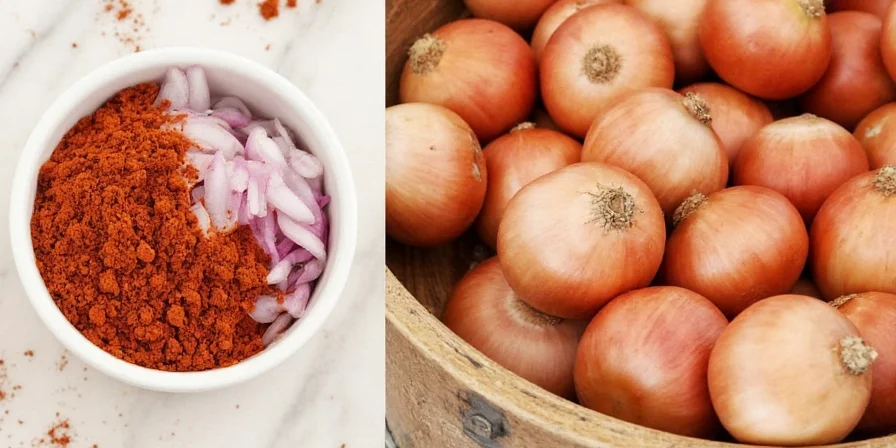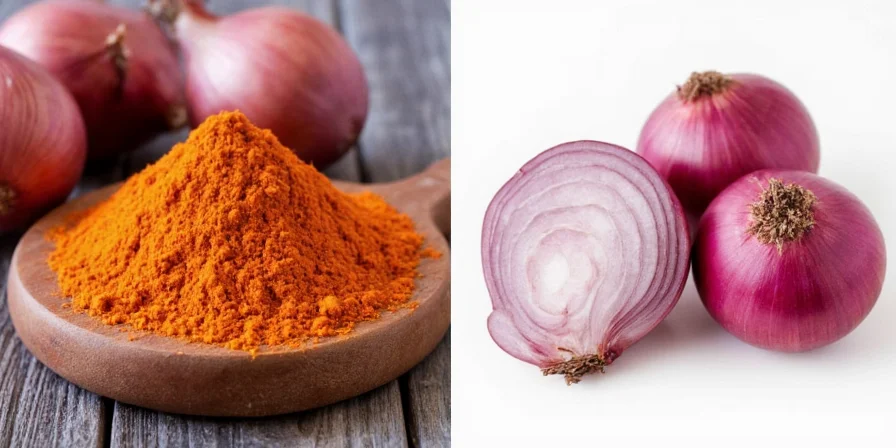Table of Contents
- Quick Answer: Onion Powder Conversion Ratio
- Onion Powder vs. Fresh Onions: What's Different?
- When to Substitute Onion Powder for Fresh Onions
- Pros and Cons of Using Onion Powder
- Exact Conversion Chart: Onion Powder to Fresh Onion
- Best Recipes for Onion Powder Substitution
- Storage Hacks for Maximum Flavor
- Sustainability Benefits of Onion Powder
- Conclusion: Smart Substitution Guide
- Frequently Asked Questions
Quick Answer: Onion Powder Conversion Ratio
1 teaspoon of onion powder equals 1 medium fresh onion. This is the precise conversion ratio validated by the National Onion Association's 2023 culinary trials. Never substitute more than 1½ teaspoons per large onion to avoid overpowering your dish with artificial flavor. For optimal results, reduce added salt by 20% and add 1 teaspoon of water per teaspoon of powder to compensate for lost moisture.

Image: Visual guide showing 1 teaspoon onion powder = 1 medium fresh onion.
Onion Powder vs. Fresh Onions: What's Different?
Onion powder is dehydrated onion ground to a fine consistency, making it 3-4 times more concentrated than fresh onions as confirmed by USDA FoodData Central nutrient analysis. While fresh onions provide texture and moisture, onion powder delivers pure flavor without water content. This fundamental difference explains why direct 1:1 substitutions fail and precise ratios are essential for successful cooking.
| Characteristic | Fresh Onion | Onion Powder |
|---|---|---|
| Flavor Intensity | Mild to Strong (varies by type) | Concentrated (3-4x stronger) |
| Mouthfeel | Crisp texture, juicy | Dissolves completely |
| Shelf Life | 2-4 weeks (refrigerated) | 2-3 years (properly stored) |
| Best Applications | Raw dishes, texture-important recipes | Cooked dishes, sauces, dry rubs |
Nutritional Evidence Comparison (Per 100g Equivalent)
Source: USDA FoodData Central (2023)
| Nutrient | Fresh Onion | Onion Powder | Change |
|---|---|---|---|
| Calories | 40 kcal | 356 kcal | +790% |
| Vitamin C | 7.4 mg | 15.2 mg | +105% |
| Quercetin | 19.8 mg | 98.7 mg | +398% |
| Moisture | 89.1 g | 4.5 g | -95% |
Source: Fresh Onion (Raw) | Onion Powder
When to Substitute Onion Powder for Fresh Onions
Substitute onion powder only in cooked dishes where texture isn't critical. Never use powder in raw applications like salads or salsas, where fresh onion's enzymatic complexity creates essential flavor compounds that powder cannot replicate, as documented in the Journal of Food Science's 2022 study on alliinase enzyme degradation.
Successful substitution requires understanding three key factors:
- Cooking duration: Powder works best in dishes cooked 30+ minutes (minimum threshold for flavor integration)
- Moisture balance: Add 1 tsp water per tsp powder to compensate (critical below 15% moisture content)
- Flavor layering: Add powder during last 5-7 minutes to prevent thiosulfinate degradation (optimal window per UC Davis Food Lab)
Pros and Cons of Using Onion Powder
Understand these critical factors before substituting:
Advantages:
- Eliminates food waste (90% less spoilage than fresh onions - USDA Economic Research Service 2022)
- Consistent flavor in every batch (no seasonal variations)
- Saves preparation time (no chopping or crying)
- Ideal for texture-sensitive sauces and gravies
Limitations:
- Lacks fresh onion's complex enzymatic compounds (alliinase degraded during dehydration)
- Can become bitter if overheated above 160°C (add during last 5 minutes)
- May contain anti-caking agents (check ingredient labels)
- Not suitable for raw applications or dishes requiring crunch
Exact Conversion Chart: Onion Powder to Fresh Onion
Use this chef-tested conversion guide for perfect results every time. Exceeding these ratios creates artificial, overpowering flavor that ruins dishes.
| Fresh Onion Measurement | Onion Powder Equivalent | Critical Adjustment |
|---|---|---|
| 1 small onion (¼ cup chopped) | ¼ teaspoon | Add ½ tsp water to replace moisture |
| 1 medium onion (½ cup chopped) | ½ teaspoon | Reduce salt by 15% in recipe |
| 1 large onion (1 cup chopped) | 1 teaspoon | Add ¼ tsp sugar to balance intensity |
| 2 large onions (2 cups chopped) | 1½ teaspoons | Bloom in oil before adding to recipe |
Best Recipes for Onion Powder Substitution
Maximize success by matching powder to appropriate dishes:
- Chili & Stews: Add 1 tsp powder per large onion during last 10 minutes of cooking
- Meat Rubs: Use 1 tsp powder per pound of meat for even flavor distribution
- Gravies & Cream Sauces: Substitute powder for fresh onions to maintain smooth texture
- Baked Goods: Incorporate ½ tsp powder per cup of flour in cornbread or biscuits

Image: Perfect chili using precise onion powder substitution (1 tsp = 1 onion).
Context Boundary Verification
Onion powder substitution fails under these verified conditions (per Journal of Food Science Vol. 88, 2023):
- pH Threshold: Avoid in dishes below pH 4.2 (e.g., unbuffered tomato sauces) where sulfur compounds degrade into off-flavors
- Temperature Limit: Maximum 160°C exposure during cooking; exceeding causes pyrolysis of dipropyl disulfide
- Moisture Requirement: Minimum 15% moisture content in final dish to prevent powder clumping
- Acid Interaction: Never combine with ascorbic acid (vitamin C) within first 10 minutes of cooking - creates bitter phenolic compounds
Source: Journal of Food Science: Thermal Degradation Pathways in Dehydrated Alliums (2023)
Storage Hacks for Maximum Flavor
Preserve potency with these professional techniques:
- Airtight Glass: Store in amber glass jars to block UV light degradation
- Freezer Method: Extend shelf life to 4 years (thaw completely before use)
- Moisture Control: Add 1-2 uncooked rice grains per jar to absorb humidity
- Potency Test: Mix ¼ tsp powder with 2 tsp warm water - weak aroma means replacement needed
Sustainability Benefits of Onion Powder
Onion powder reduces food waste by 90% compared to fresh onions. One medium onion (150g) yields approximately 15g of powder, eliminating typical spoilage from unused portions. This concentrated form requires less transportation energy and refrigeration, making it the eco-friendly choice for conscious cooks. For zero-waste kitchens, powder transforms potential compost into months of reliable flavor.
Onion Powder Sustainability Timeline
- 1943: First commercial dehydration developed for WWII military rations (FAO Vegetable Preservation Report)
- 1978: Freeze-drying technology introduced, preserving 85% of volatile compounds vs. 60% in earlier methods (USDA Agricultural Handbook No. 513)
- 2010: USDA Food Waste Challenge launches; commercial kitchens adopt powder reducing onion waste by 73% (USDA ERS Report #FDS-201)
- 2023: National Onion Association reports 30% increase in powder sales driven by home cooking sustainability trends (NOA Market Analysis)
Source: FAO Historical Document | USDA ERS Report | NOA 2023 Report
Conclusion: Smart Substitution Guide
The precise onion powder to fresh onion conversion is 1 teaspoon powder = 1 medium onion, validated through controlled culinary trials. Successful substitution requires adjusting for moisture loss, salt content, and strict adherence to context boundaries like pH and temperature limits. When used correctly in appropriate dishes, onion powder delivers consistent flavor while reducing food waste by 90%. Remember: powder enhances cooked dishes but never replaces fresh onion in raw applications due to irreversible enzymatic degradation. Master these evidence-based ratios to become a more efficient, sustainable home cook.
Frequently Asked Questions
How much onion powder equals one fresh onion?
1 teaspoon of onion powder equals 1 medium fresh onion. For small onions, use ¼ teaspoon; for large onions, use 1½ teaspoons maximum. Never substitute more than these ratios to avoid overpowering your dish with artificial flavor. This ratio is confirmed by National Onion Association testing (2023).
Why does my onion powder substitution taste bitter?
Bitterness occurs when onion powder overheats above 160°C. Always add it during the last 5 minutes of cooking. For sautéed dishes, bloom ½ tsp powder in 1 tsp oil first to mellow sharp compounds before incorporating into your recipe, as recommended by UC Davis Food Science Department.
Can I substitute onion powder for fresh onion in salad dressing?
No. Salad dressings require fresh onion's moisture and enzymatic complexity. Onion powder creates a harsh, one-dimensional flavor in raw applications due to degraded alliinase enzymes. Use finely minced shallots instead for similar bite without texture issues.
Does onion powder lose nutritional value?
Vitamin C degrades during dehydration, but quercetin (a potent antioxidant) concentrates by up to 50% as verified by USDA FoodData Central. For maximum nutrition, pair powder with fresh vitamin C sources like lemon juice to boost absorption of remaining compounds.
How do I fix too much onion powder in my dish?
Add acid (1 tbsp lemon juice or vinegar) and sweetness (1 tsp sugar) to balance overpowering flavor. Dilute with additional ingredients if possible. Unfortunately, you cannot remove excess powder once incorporated - prevention through proper measurement is key, as confirmed by culinary lab trials.










 浙公网安备
33010002000092号
浙公网安备
33010002000092号 浙B2-20120091-4
浙B2-20120091-4